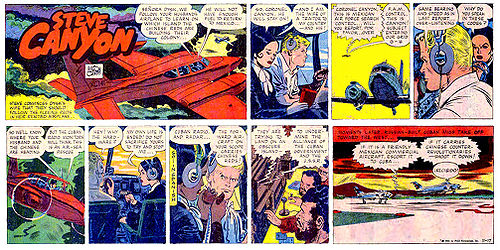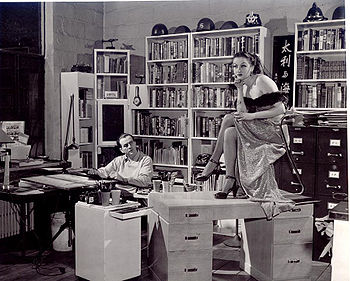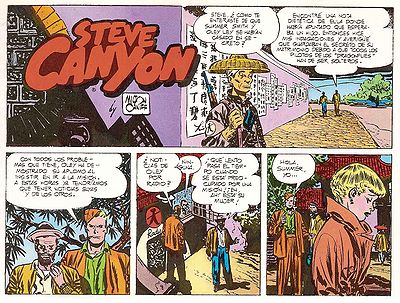
Steve Canyon
Encyclopedia

United States
The United States of America is a federal constitutional republic comprising fifty states and a federal district...
adventure
Adventure
An adventure is defined as an exciting or unusual experience; it may also be a bold, usually risky undertaking, with an uncertain outcome. The term is often used to refer to activities with some potential for physical danger, such as skydiving, mountain climbing and or participating in extreme sports...
comic strip
Comic strip
A comic strip is a sequence of drawings arranged in interrelated panels to display brief humor or form a narrative, often serialized, with text in balloons and captions....
by writer-artist Milton Caniff
Milton Caniff
Milton Arthur Paul Caniff was an American cartoonist famous for the Terry and the Pirates and Steve Canyon comic strips.-Biography:...
. Launched shortly after Caniff retired from his previous strip, Terry and the Pirates
Terry and the Pirates (comic strip)
Terry and the Pirates was an action-adventure comic strip created by cartoonist Milton Caniff. Captain Joseph Patterson, editor for the Chicago Tribune New York News Syndicate, had admired Caniff’s work on the children's adventure strip Dickie Dare and hired him to create the new adventure strip,...
, Steve Canyon ran from January 13, 1947 until June 4, 1988, shortly after Caniff's death. Caniff won the Reuben Award for the strip in 1971.
History
By 1946, Caniff had developed a worldwide reputation for his syndicatedSyndicate
A syndicate is a self-organizing group of individuals, companies or entities formed to transact some specific business, or to promote a common interest or in the case of criminals, to engage in organized crime...
Terry and the Pirates. However, the rights for the strip he had created, written and drawn (for Chicago Tribune
Chicago Tribune
The Chicago Tribune is a major daily newspaper based in Chicago, Illinois, and the flagship publication of the Tribune Company. Formerly self-styled as the "World's Greatest Newspaper" , it remains the most read daily newspaper of the Chicago metropolitan area and the Great Lakes region and is...
newspaper syndicate editor Captain Joseph Patterson), were entirely owned by the syndicate. Seeking creative control, Caniff negotiated with Field Enterprises
Field Enterprises
Field Enterprises was a private holding company founded on August 31, 1944, by Marshall Field III and others whose main asset was the Chicago Sun. That same year the company acquired the book publishers Simon & Schuster and Pocket Books....
for a new strip on which he could retain ownership. The last Caniff episode of Terry and the Pirates appeared in December 1946, and then George Wunder
George Wunder
George S. Wunder was a cartoonist best known for his 26 years illustrating the Terry and the Pirates comic strip....
took over the strip. Caniff's new strip, Steve Canyon, debuted in 168 newspapers.
Many strip creators before and since employ uncredited assistants or ghost artists, and Caniff was no exception. In 1952, he hired comic book
Comic book
A comic book or comicbook is a magazine made up of comics, narrative artwork in the form of separate panels that represent individual scenes, often accompanied by dialog as well as including...
artist Dick Rockwell
Dick Rockwell
Richard Waring Rockwell is an American comic strip and comic book artist best known as Milt Caniff's uncredited art assistant for 35 years on the adventure strip Steve Canyon...
(nephew of famed illustrator Norman Rockwell
Norman Rockwell
Norman Percevel Rockwell was a 20th-century American painter and illustrator. His works enjoy a broad popular appeal in the United States for their reflection of American culture. Rockwell is most famous for the cover illustrations of everyday life scenarios he created for The Saturday Evening...
) as his assistant. While Caniff scripted and drew the main characters, Rockwell penciled and inked
Inker
The inker is one of the two line artists in a traditional comic book or graphic novel. After a pencilled drawing is given to the inker, the inker uses black ink to produce refined outlines over the pencil lines...
secondary characters and backgrounds. Rockwell continued on Canyon until Caniff's death on May 3, 1988.

Bill Mauldin
William Henry "Bill" Mauldin was a two-time Pulitzer Prize-winning editorial cartoonist from the United States...
, the other containing the signatures of 78 fellow cartoonists.
On June 23, 1997, an authorized 50th anniversary Steve Canyon strip was published by the Air Force Times
Air Force Times
Air Force Times is a weekly newspaper serving active, reserve and retired United States Air Force and Air National Guard personnel and their families, providing news, information and analysis as well as community and lifestyle features, educational supplements, and resource guides.Air Force Times...
, a civilian weekly newspaper covering the United States Air Force
United States Air Force
The United States Air Force is the aerial warfare service branch of the United States Armed Forces and one of the American uniformed services. Initially part of the United States Army, the USAF was formed as a separate branch of the military on September 18, 1947 under the National Security Act of...
. Steve Canyon and the U.S. Air Force having been created the same year, the shared anniversary was celebrated with Steve Canyon appearing as part of a 96-page insert, The First Fifty Years: U.S. Air Force 1947-1997. Drawn in the style of a Sunday strip
Sunday strip
A Sunday strip is a newspaper comic strip format, where comic strips are printed in the Sunday newspaper, usually in a special section called the Sunday comics, and virtually always in color. Some readers called these sections the Sunday funnies...
, the story and art for this commemorative were provided by Air Force Master Sergeant Russ Maheras, with coloring by Carl Gafford
Carl Gafford
Carl Gafford is a colorist who has worked for several decades in the comics industry. His career to date has spanned several publishers, including Marvel Comics, DC Comics and Topps Comics.- Early life :...
. On Monday, September 24, 2007, Air Force Times published a 60th anniversary Steve Canyon strip by Maheras. The color, Sunday-style strip depicts Brigadier General Steve Canyon in Afghanistan, investigating Taliban activity.
Characters and story
Steve Canyon was an easygoing adventurer with a soft heart. Originally a veteran running his own air-transport business, the character returned to the U.S. Air Force during the Korean WarKorean War
The Korean War was a conventional war between South Korea, supported by the United Nations, and North Korea, supported by the People's Republic of China , with military material aid from the Soviet Union...
and stayed in the military for the remainder of the strip's run.
Initially, his buddies were fellow veterans, and romantic interest was provided by Copper Calhoon, a kind of capitalist version of the popular Dragon Lady character Caniff had created for Terry and the Pirates. Eventually, Canyon developed a sometime-sidekick in crotchety millionaire adventurer Happy Easter, along with a permanent love interest in Summer Olson, Calhoon's private secretary (Canyon and Olson were pronounced "man and wife" in the first panel of the April 25, 1970 daily strip). General Philerie was based on legendary World War II hero Phil Cochran, who came from Erie
Erie, Pennsylvania
Erie is a city located in northwestern Pennsylvania in the United States. Named for the lake and the Native American tribe that resided along its southern shore, Erie is the state's fourth-largest city , with a population of 102,000...
, as noted in the character's name (Phil-Erie). Cochran had been the model for Flip Corkin from Terry and the Pirates and Canyon included a Terry-like major character called Reed Kimberley.
Caniff was intensely patriotic, and with Canyon's return to the military, the story began to revolve around Cold War
Cold War
The Cold War was the continuing state from roughly 1946 to 1991 of political conflict, military tension, proxy wars, and economic competition between the Communist World—primarily the Soviet Union and its satellite states and allies—and the powers of the Western world, primarily the United States...
intrigue and the responsibilities of American citizens. Despite this shift in tone, Caniff was able to maintain the picaresque quality of his globally set stories.
Models

Femme fatale
A femme fatale is a mysterious and seductive woman whose charms ensnare her lovers in bonds of irresistible desire, often leading them into compromising, dangerous, and deadly situations. She is an archetype of literature and art...
spy played by Ilona Massey
Ilona Massey
Ilona Massey was a film, stage and radio performer.-Early life and career:...
in the Marx Brothers
Marx Brothers
The Marx Brothers were an American family comedy act, originally from New York City, that enjoyed success in Vaudeville, Broadway, and motion pictures from the early 1900s to around 1950...
movie Love Happy
Love Happy
Love Happy was the 14th and last starring feature for the Marx Brothers. The film stars Harpo Marx, Chico Marx, and, in a smaller role than usual, Groucho Marx, plus Ilona Massey, Vera-Ellen, Paul Valentine, Marion Hutton, Raymond Burr, Bruce Gordon , and Eric Blore, with a walk-on by Marilyn Monroe...
(1949). The character stirred Caniff's imagination so much that he hired Ilona Massey personally to pose for him. Besides casting Ilona Massey as Lynx, Caniff also patterned Pipper the Piper after John Kennedy and Miss Mizzzou after Marilyn Monroe
Marilyn Monroe
Marilyn Monroe was an American actress, singer, model and showgirl who became a major sex symbol, starring in a number of commercially successful motion pictures during the 1950s....
The character of Charlie Vanilla (who would frequently appear with an ice cream cone in hand) was based on Caniff's longtime friend Charles Russhon
Charles Russhon
Charles J. Russhon was an American photographer and Lieutenant Colonel in the United States Air Force who later became noted for his role as a technical adviser and liaison officer on the Sean Connery and Roger Moore James Bond films of the 1960s and 1970s.He served as a photographer in World War...
, a former photographer and U.S. Air Force lieutenant who became a technical advisor on five James Bond
James Bond
James Bond, code name 007, is a fictional character created in 1953 by writer Ian Fleming, who featured him in twelve novels and two short story collections. There have been a six other authors who wrote authorised Bond novels or novelizations after Fleming's death in 1964: Kingsley Amis,...
films.
Comics and strip collections
Harvey ComicsHarvey Comics
Harvey Comics was an American comic book publisher, founded in New York City by Alfred Harvey in 1941, after buying out the small publisher Brookwood Publications. His brothers Robert B...
reprinted the strip in a half-dozen 1948 comic books, and Dell Comics
Dell Comics
Dell Comics was the comic book publishing arm of Dell Publishing, which got its start in pulp magazines. It published comics from 1929 to 1973. At its peak, it was the most prominent and successful American company in the medium...
published seven issues of original stories (1953-59) by former Caniff assistant Ray Bailey (who had anticipated Steve Canyon with his own Bruce Gentry
Bruce Gentry
Bruce Gentry is a Columbia movie serial based on the Bruce Gentry comic strip created by Ray Bailey. It may contain the first cinematic appearance of a Flying Saucer, here the secret weapon of the villainous Recorder.-Plot:...
about a charter pilot) in their Four Color
Four Color
Four Color, also known as Four Color Comics and One Shots, was a long-running American comic book anthology series published by Dell Comics between 1939 and 1962...
series (#519, 578, 641, 737, 804, 939, 1033). Steve Canyon was reprinted by The Menomonee Falls Gazette
The Menomonee Falls Gazette
The Menomonee Falls Gazette was a weekly tabloid that reprinted newspaper comic strips from USA and UK. The first issue was published December 11, 1972, with the last issue on March 3, 1978...
, Kitchen Sink Press
Kitchen Sink Press
Kitchen Sink Press was a comic book publishing company founded by Denis Kitchen in 1970. Kitchen owned and operated Kitchen Sink Press until 1999. Kitchen Sink Press was a pioneering publisher of underground comics, and was also responsible for numerous republications of classic comic strips in...
and Comics Revue
Comics Revue
Comics Revue is a bi-monthly small press comic book published by Manuscript Press and edited by Rick Norwood. Don Markstein edited the publication from 1984 to 1987 and 1992 to 1996....
, with Hermes Press to reprint the Dell Comics series.

- Steve Canyon v.22 In Formosa's Dire Straits (1989, ISBN 0-87816-044-2, reprints Feb 8, 1955 to August 8, 1955)
- Steve Canyon v.23 The Scarlet Princess (1989, reprints August 9, 1955 to April 11, 1956)
- Steve Canyon v.24 Taps for 'Shanty' Town (1989, reprints April 12, 1956 to November 28, 1956)
- Steve Canyon v.25 Damma Exile (1991, ISBN 0-87816-061-2, reprints Nov 29, 1956 to Sept 24, 1957)
- Steve Canyon v.26 War Games (1992, ISBN 0-87816-066-3, reprints Sept 25, 1957 to April 7, 1958)
Kitchen Sink Press also published a one-shot Steve Canyon 3-D comic in June 1986 featuring an anaglyph 3D process by Ray Zone.
In 2006, Checker Book Publishing Group
Checker Book Publishing Group
Checker Book Publishing Group is an independent publisher of comics reprints, from newspaper strips to modern out-of-print titles and collections from defunct publishers.-History:...
began releasing a year-by-year collection of Steve Canyon:
- Steve Canyon: 1947 (ISBN 0-9710249-9-5)
- Steve Canyon: 1948 (ISBN 0-9741664-1-3)
- Steve Canyon: 1949 (ISBN 0-9710249-1-X, February 9, 1949 and February 18, 1950)
- Steve Canyon: 1950 (ISBN 1-933160-51-9, reprints January 29 to October 7, 1950)
- Steve Canyon: 1951 (ISBN 1-933160-10-1, reprints October 8, 1950 to Nov 14, 1951)
- Steve Canyon: 1952 (ISBN 1-933160-55-1, reprints April 9, 1952 to May 14, 1953)
- Steve Canyon: 1953 (ISBN 1-933160-57-8, reprints May 15, 1953 to August 5, 1954)
- Steve Canyon: 1954 (ISBN 1-933160-23-3, reprints August 6, 1954 to August 8, 1955)
- Steve Canyon: 1955 (ISBN 978-1-93316073-3, reprints August 9, 1955 to 1956; new format)
Television
The strip was adapted into a filmed, half-hour television series of 34 episodes on NBCNBC
The National Broadcasting Company is an American commercial broadcasting television network and former radio network headquartered in the GE Building in New York City's Rockefeller Center with additional major offices near Los Angeles and in Chicago...
in 1958–59 (with reruns on ABC
American Broadcasting Company
The American Broadcasting Company is an American commercial broadcasting television network. Created in 1943 from the former NBC Blue radio network, ABC is owned by The Walt Disney Company and is part of Disney-ABC Television Group. Its first broadcast on television was in 1948...
in 1960). Dean Fredericks
Dean Fredericks
Dean Fredericks was an American actor best known for his portrayal of the comic strip character Steve Canyon in a 34-episode television series of the same name which aired from 1958-1959 on NBC. He was born Frederick Joseph Foote in Los Angeles, California...
(1924–99), formerly the Hindu
Hindu
Hindu refers to an identity associated with the philosophical, religious and cultural systems that are indigenous to the Indian subcontinent. As used in the Constitution of India, the word "Hindu" is also attributed to all persons professing any Indian religion...
manservant on Johnny Weissmuller
Johnny Weissmuller
Johnny Weissmuller was an Austro-Hungarian-born American swimmer and actor best known for playing Tarzan in movies. Weissmuller was one of the world's best swimmers in the 1920s, winning five Olympic gold medals and one bronze medal. He won fifty-two US National Championships and set sixty-seven...
's 1955–56 Jungle Jim
Jungle Jim (TV series)
Jungle Jim is a 26-episode syndicated adventure television series which aired from 1955-1956, starring Johnny Weismuller, as Jim "Jungle Jim" Bradley, a hunter, guide, and explorer in, primarily, Africa. The program should not be confused with Ramar of the Jungle, but is based on the Jungle Jim...
series, played Canyon—a troubleshooter for the United States Air Force
United States Air Force
The United States Air Force is the aerial warfare service branch of the United States Armed Forces and one of the American uniformed services. Initially part of the United States Army, the USAF was formed as a separate branch of the military on September 18, 1947 under the National Security Act of...
, spending half the season traveling from base to base before becoming the commanding officer stationed at the strip's fictitious Big Thunder Air Force Base in California
California
California is a state located on the West Coast of the United States. It is by far the most populous U.S. state, and the third-largest by land area...
. With the exception of General "Shanty" Towne (in the pilot episode), none of the other supporting characters from the newspaper strip appeared in the series.

